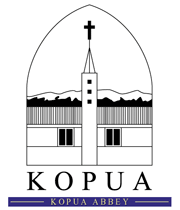Our Lady of the Southern Star Abbey (Kopua) is the only Cistercian monastery in New Zealand. Kopua was founded by Mount Melleray Abbey, Ireland in 1954. The monks of Kopua belong to the worldwide Cistercian Order of the Strict Observance (OCSO), popularly known as the “Trappists”.
At the heart of the monastic life is the search for God. We seek God and follow Christ in a life of prayer and community, solitude and simplicity, work and hospitality.
We follow the Rule of St Benedict, an ancient source of monastic wisdom that continues to guide many people in search of an authentic spiritual path in today’s world.
Our Place
The Abbey is situated in a beautiful, relatively remote, rural area of New Zealand on a dairy farm between Dannevirke and Waipukurau, Central Hawke’s Bay.
Visitors
Visitors are always welcome at the Monastery. Guests are invited to share in the monastic services and to enjoy the peace of this sacred place. Those who may wish to have a deeper experience of the life are able to stay in the monastery guesthouse. Prior booking is essential.
Mass Times
Sunday: Community Mass at 10.00am
Weekdays: Community Mass at 8.00am
Contact Us
Telephone
Monastery:
+64 6 855 8239
Suitable times to telephone:
9.00am – 11.15am, 2.15pm – 6.00pm
Administration/vocations:
abbot@kopuamonastey.org.nz
Guesthouse/retreats:
kopuabookings@gmail.com

